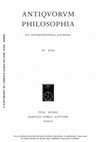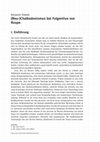Papers by Benjamin Gleede
From Protology to Eschatology and Back Again, 2022
The paper examines the claim most prominently made in the Christian Topography that the Christian... more The paper examines the claim most prominently made in the Christian Topography that the Christian believe in a resurrection of the flesh presupposes inhabitable three-dimensional space in heaven, a heavenly habitat, one floor above the earthly one.
Platonism and Christianity in Late Ancient Cosmology, 2022
Ancient Christian "flat-earthers" are examined as to their backgrounds and motives.

Sacris erudiri, 2022
The Latin dossier on Theodore the Recruit derives in its entirety from the early fifth century Gr... more The Latin dossier on Theodore the Recruit derives in its entirety from the early fifth century Greek Passio (BHG 1761-62. During the seventh and eighth centuries, the West became acquainted with two versions of it: the older one (BHL 8078) is based on a lost recension of the Greek text which had combined Theodore with Eutropius und Basiliscus in order to present a triad of iconoclast soldier saints. This older version also exists in a slightly better attested redaction of Northern French origin (BHL 8079). The Latin standard text (BHL 8077), however, results from an original (re-) translation of BHG 1761, which also relies on the earlier version 8078 and other Latin Martyria of similar content, such as the Martyrdom of Polycarp or the Passio Nestoris. Both the relatively high quality of the translations and the development of Theodore's cult in the West speak to their Italian origin, at some point between the late and early eigth centuries.

Ephemerides Theologicae Lovanienses, 2022
The Latin transmission of the Martyrdom of Polycarp, particularly its different versions and thei... more The Latin transmission of the Martyrdom of Polycarp, particularly its different versions and their relationship to one another, presents one of the many problems in parabiblical literature that-in contrast to the considerable effort that has been invested in New Testament studies all over the world-remains virtually untouched by scholarship since the time of Adolf von Harnack 1. Unlike the Latin versions of the Letter to Polycarp and the Shepherd of Hermas 2 , the Latin versions of the Martyrdom seem to contribute little to our understanding of the original Greek text. Nevertheless, the following contribution will show that the Latin versions of the Martyrdom furnish an interesting showcase for the Latin reception of parabiblical literature from the postapostolic age. The Latin Martyrdom has come down to us basically in three versions. The most influential is Rufinus' translation of the passage in Eusebius' Ecclesiastical History, where the bishop of Caesarea quotes most of the extant Greek text, but also paraphrases some passages, which makes it unclear whether he actually knew the Martyrdom in the so-called Pionius recension, which is preserved by the extant Greek manuscripts and the
Endorsing a cliché. On liberty and necessity in the Christian and Neoplatonist account of creation
More Zoroastrian Than Zoroaster? The Problem of Zoroastrian Influence on Manichaeism Illustrated by a Version of the Manichaean Myth Preserved in Severus of Antioch, Titus of Bostra and Theodoret of Cyrus
Christian Apologetics or Confessional Polemics? Context and Motivation of Philoponus’ De opificio mundi

Arabic Sciences and Philosophy, 2012
The article aims at demonstrating that in attributing the creatio ex nihilo to both Plato and Ari... more The article aims at demonstrating that in attributing the creatio ex nihilo to both Plato and Aristotle as their unanimous philosophical conviction the Treatise on the Harmony between the Two Sages deeply depends upon the Neoplatonic reading of those two philosophers. The main obstacles for such a view in the works of the two sages are Plato's assumption of a precosmic chaos in the Timaeus and Aristotle's denial of any efficient causality to the unmoved mover in the Metaphysics. Both of these points had been, however, done away with by the Neoplatonist commentators already, especially by Ammonius in his lost treatise on efficient and final causality in Aristotle the use of which in the Harmony is shown by a comparison with Simplicius. Christian and Muslim readers just had to transfer those arguments and hermeneutical techniques into an anti-eternalist context in order to make the two philosophers agree with one of the basic tenents of their face, a hermeneutical technique co...

PRIMORDIAL CHAOS IN GEN 1:2? AN EXEGETICAL PROBLEM FOR EARLY CHRISTIANITY IN THE LIGHT OF ITS DOMINANTLY PLATONIZING METAPHYSICAL PRESUPPOSITIONS, 2022
As the creation accounts of both the Platonic Timaeus und the Mosaic Genesis seem to present a cr... more As the creation accounts of both the Platonic Timaeus und the Mosaic Genesis seem to present a creator God bringing order into primordial chaos, both Platonism and Christianity had to face the challenge of reconciling this duality of “principles” with their tendency towards theoretical monism. Whereas for Platonists, metaphysical presuppositions easily overruled the controversial data of their authoritative text at least from Plotinus onwards, the Christian theological discourse was characterized by a constant struggle between a literal reading of the six days of creation, which tended to reinterpret the apparent primordial chaos as created terminus a quo of the divine providential intervention, and a consequent allegorization of those “days” as merely displaying the order and hierarchy within the simultaneously created reality. Whereas the former position was most influentially argued for by the so-called “school of Antioch” (John Chrysostom, Theodore of Mopsuestia), the most prominent exponents of the latter were Origen and Augustine.
Christian philosophy in Severus of Antioch and Leontius of Byzantium
Τὸ ὅλον θεολογεῖν καὶ τὸ ὅλον ἀνθρωπολογεῖν. Der Sprachgebrauch der Schrift als Wurzel apollinarischer Christologie
Johannes Philoponos und die christliche Apologetik. Die Widerlegungen des Proklos und Aristoteles und die Debatte des Schöpfungsproblems in der Schule von Gaza und bei Ps-Justin
Epistula ecclesiae Smyrnensis de passione Polycarpi (BHL 6870) : Kritische Präliminaredition
Sacris Erudiri

Das Christentum im frühen Europa
Chalkedonismus bei Fulgentius von Ruspe 1E inführung Das vierte ökumenische Konzil, im Jahr 451d ... more Chalkedonismus bei Fulgentius von Ruspe 1E inführung Das vierte ökumenische Konzil, im Jahr 451d urch Kaiser Markian im hauptstadtnahen Chalkedon veranstaltet,k önnte man in vielerlei Hinsicht als eine Katastrophe historischen Ausmaßes besonders für die orientalische Christenheit ansehen, welche sich im Prinzipb is heute nicht vond essen Folgen erholen konnte. An der dort hauptsächlich vond en kaiserlichen Legatene rzwungenen Glaubensdefinition entzündete sich die erste bleibendeK irchenspaltung der Christentumsgeschichte, verbunden mitjahrhundertelangen, teilweise recht gewalttätigenAuseinandersetzungen zwischenC halkedoniern, Monophysiten und Nestorianern, welche daso rientalische Christentum sowie das byzantinische Reich derartig schwächten, dass sie der islamischen Eroberungd es siebten Jahrhunderts nicht nur nichts entgegenzusetzen hatten, sondern diese stellenweise sogar begrüßt wurde, namentlich im mehrheitlich monophysitisch geprägten Ägypten. Dass dies im Westen völlig anders verlief und das Konzil so schnell zum Shibbolethm indestens der nizänischen Orthodoxie wurde, so dass jeder Anschein seiner Kompromittierung, etwa durch Justinians Drei-Kapitel-Edikt,erbittertsten Widerstand hervorrief,¹ hat natürlich vielerlei Ursachen. Primärv erdankt es sich wohl der Tatsache, dass der führende Theologeh inter Chalkedon, Papst LeoI ., dessen berühmter Tomus gleichsam die theologische Konkretion zum abstraktenF ormelkompromiss der Glaubensdefinition lieferte, zunächstP rimas des Westens war und seine Nachfolgerauf seine Theologie verpflichtete. Zudem war Leos Christologie auch noch in hohem Maße vonA ugustinus geprägt,² der trotz einiger umstrittener Punkte seiner Theologie sehrs chnell zum Normaltheologen des lateinischen Christentums aufstieg. Während es im Osten eben das Festhalten einer großen Mehrheit an der kyrillianischen Formel vond er μίαφ ύ σις τοῦ θεοῦ λόγου σεσαρκωμένη war,welche mit dem chalkedonischen, bei keinem namhafteng riechischen Theologen vorheri n dieser Form zu belegendenFormelkompromiss vonden δύοφύσεις ἐνμίᾳ ὑποστάσει ἢ ἑνὶ προσώπῳ unvereinbar erschien und somit deren Akzeptanz erschwerte oder verhinderte, warend ie duae naturae in una persona im Westen keineswegse rst durch Papst Leoe ingeführt worden, sondern bereits seit Tertullian bekannt und durch die Autorität Augustins sanktioniert,i llustriert und popularisiert.D ie chalkedonische Christologie war also für den Westen, mindestens in Gestalt des Tomus Leonis,weder
The Ps.-Justinian Corpus of Erotapokriseis and Apologetical Treatises. In Search of an Author and a Historical Setting
Lectio
Antiochenische Kosmographie?
Christoph Riedweg und Wolfram Kinzig, Hgg.: Kyrill von Alexandrien, Werke 1: „Gegen Julian“ Teil 1: Buch 1–5, GCS.NF 20, Berlin (de Gruyter) 2016, CCXXXIII + 407 S., ISBN 978-3-11-035914-5, 119,95 €; Wolfram Kinzig und Thomas Brüggemann, Hgg.: Kyrill von Alexandrien, Werke 2: „Gegen Julian“ Teil ...
Zeitschrift für Antikes Christentum / Journal of Ancient Christianity
Yonathan Moss: Incorruptible Bodies: Christology, Society, and Authority in Late Antiquity, Christianity in Late Antiquity, Oakland (University of California Press) 2016, XIV + 244 S., ISBN 978-0-520-28999-4, $ 95,–
Zeitschrift für Antikes Christentum / Journal of Ancient Christianity
Diodore of Tarsus
Encyclopedia of the Bible Online
Chalcedon, Council of
Encyclopedia of the Bible Online










Uploads
Papers by Benjamin Gleede